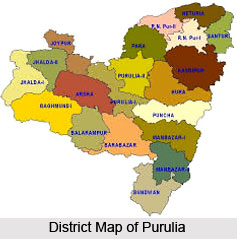 Administration of Purulia district in West Bengal is carried out by the District magistrate. He is also the District collector and also the executive officer of the Zilla Parishad. In the administration of the district he is assisted by the Additional district magistrate (general), Additional District Magistrate (Development), Additional Executive Officer, Additional District Magistrate and D.L. and L.R.O, S.D.O (Sadar East), S.D.O. (Sadar West), S.D.O. (Raghunathpur), B.D.O.s of 20 Blocks and by other Officers.
Administration of Purulia district in West Bengal is carried out by the District magistrate. He is also the District collector and also the executive officer of the Zilla Parishad. In the administration of the district he is assisted by the Additional district magistrate (general), Additional District Magistrate (Development), Additional Executive Officer, Additional District Magistrate and D.L. and L.R.O, S.D.O (Sadar East), S.D.O. (Sadar West), S.D.O. (Raghunathpur), B.D.O.s of 20 Blocks and by other Officers.
There are three Sub-divisions under Purulia District namely:
1. Purulia Sadar East
2. Purulia Sadar West
3. Raghunathpur
The overall administration of the district is seen to by the District Magistrate and he is required to oversee the functioning of a number of departments and bodies falling under his jurisdiction. For the purpose of convenient rural administration, the Zilla Parishad has been established as a part of the Panchayati Raj institution. The District Panchayat and Rural Development Office is the apex body for general supervision over administrative, financial and other functions of Panchayati Raj Institution within the district relating to institutional issues under the overall control and general supervision of the District Magistrate. District Panchayat and Rural Development Officer works under the control, supervision and direction of the District Magistrate and the primary nature of duties of the District Panchayat and Rural Development Officer are as follows:
As regards the judicial system in Purulia district, the District Court, Purulia is presided over by the District Judge. District Judge administers justice at the district level. The District Court is under administrative and judicial control of the High Court of the State to which the district concerned belongs. The highest court in each district is that of the District and Sessions Judge. This is the principal court of civil jurisdiction. This is also a court of Sessions. Sessions cases are tried by the Sessions Court. It has the power to impose any sentence including capital punishment.
There are many other courts subordinate to the court of District and Sessions Judge. There is a three tier system of courts. On the civil side, at the lowest level is the court of Civil Judge (Junior Division). On criminal side the lowest court is that of the Judicial Magistrate. Civil Judge (Junior Division) decides civil cases of small pecuniary stake. Judicial Magistrates decide criminal cases which are punishable with imprisonment of up to five years. At the middle of the hierarchy there is the Court of Civil Judge (Senior Division) on the civil side and the Court of the Chief Judicial Magistrate on the Criminal side. Civil Judge (senior division) can decide civil cases of any valuation. There are many additional courts of Additional Civil Judge (senior division).The Jurisdiction of these addition courts is the same as that of the principal court of Civil Judge (Senior Division). The Chief Judicial Magistrate can try cases which are punishable with imprisonment for a term up to seven years. Usually there are many additional courts of Additional Chief Judicial Magistrates. At the top level there may be one or more courts of additional district and Sessions Judge with the same judicial power as that of the District and Sessions judge.
Judicial independence of each court is the characteristic feature of the district judiciary. In each district there is a strong bar which ensures that courts decide cases according to law and without fear or favour. The greatest problem of district courts is that of huge backlog of cases leading to undue delay in deciding cases.






